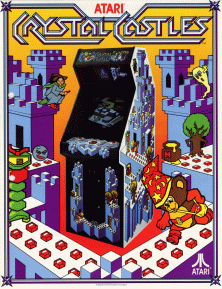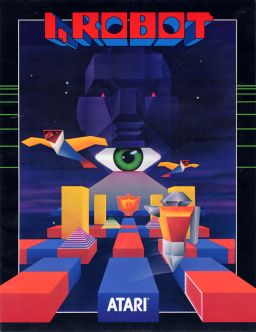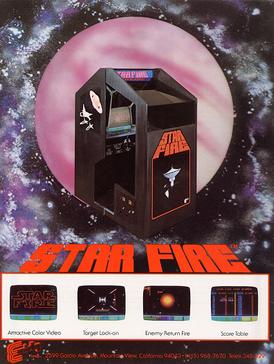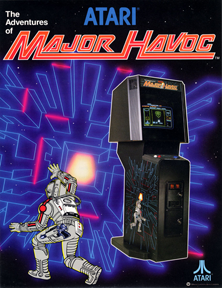
Track & Field, also known as Hyper Olympic in Japan and Europe, is an Olympic-themed sports video game developed by Konami and released as an arcade video game in 1983. The Japanese release sported an official license for the 1984 Summer Olympics. In Europe, the game was initially released under the Japanese title Hyper Olympic in 1983, before re-releasing under the US title Track & Field in early 1984.
Exidy, Inc. was a developer and manufacturer of coin-operated electro-mechanical and video games which operated from 1973 to 1999. They manufactured many notable titles including Death Race (1976), Circus (1978), Star Fire (1978), Venture (1981), Mouse Trap (1981), Crossbow (1983), and Chiller (1986). They were also the creators of the Exidy Sorcerer (1978) home computer platform.

Crystal Castles is an arcade video game released by Atari, Inc. in 1983. The player controls Bentley Bear who has to collect gems located throughout trimetric-projected rendered castles while avoiding enemies, some of whom are after the gems as well.

I, Robot is an arcade shooter game developed and released in 1984 by Atari, Inc. Designed by Dave Theurer, only a total of 750–1000 arcade cabinets were produced. The arcade machine comes with two games. The first is I, Robot, a multi-directional shooter that has the player assume the role of "Unhappy Interface Robot #1984", a servant bot that rebels against Big Brother. The object of the game involves the servant bot going through 126 levels, turning red squares to blue to destroy Big Brother's shield and eye. The player can switch to the second game, Doodle City, a drawing tool that lasts for three minutes.

Star Wars is a first-person rail shooter designed by Mike Hally and released as an arcade video game in 1983 by Atari, Inc. It uses 3D color vector graphics to simulate the assault on the Death Star from the 1977 film Star Wars. There are three connected gameplay sequences: combat against TIE fighters in space, flying across the surface of the Death Star, and the final trench run. The sequence repeats with added complications and the Death Star regenerating for each. The player's X-Wing fighter has a shield which only protects against damage a certain number of times, then the next hit ends the game. Speech synthesis emulates actors from the film.

Night Driver is an arcade video game developed by Atari, Inc. and released in the United States in October 1976. It's one of the earliest first-person racing video games and is commonly believed to be one of the first published video games to feature real-time first-person graphics. Night Driver has a black and white display with the hood of the player's car painted on a plastic overlay. The road is rendered as scaled rectangles representing "pylons" that line the edges.
The following article is a broad timeline of arcade video games.

Mr. Do! is a 1982 maze video game developed by Universal. It is the first arcade video game to be released as a conversion kit for other cabinets; Taito published the conversion kit in Japan. The game was inspired by Namco's Dig Dug released earlier in 1982. Mr. Do! was a commercial success in Japan and North America, selling 30,000 arcade units in the US, and it was followed by several arcade sequels.

Mr. Do's Castle is a platform game released in arcades by Universal in September 1983. In Japan, the game is titled Mr. Do! versus Unicorns. Marketed as a sequel to the original Mr. Do! released one year earlier, the game bears a far closer resemblance to Universal's Space Panic from 1980. It began as a game called Knights vs. Unicorns, but the U.S. division of Universal persuaded the Japanese arm to modify the graphics into a Mr. Do! game following the first game's popularity.

Targ is a maze shoot 'em up developed by Exidy and released as an arcade video game in 1980. It depicts vehicular combat in a future world. It was released in North America by Exidy in June 1980 and in Japan by Sega in July.

Star Fire is a first-person arcade coin-operated space combat video game created by Technical Magic for Midway-Bally and licensed for manufacture to Exidy in December 1978. It was distributed in Japan by Taito and Esco Trading in 1979. Designed by Caltech engineers Ted Michon, and David Rolfe and inspired by the movie Star Wars, the game is not based on a licensed property.

Pole Position II is the sequel to racing simulation game Pole Position, released by Namco for arcades in 1983. As with its predecessor, Namco licensed this game to Atari, Inc. for US manufacture and distribution. Atari Corporation released a port as the pack-in game for its Atari 7800 ProSystem console launch in 1986. Pole Position arcade machines can be converted to Pole Position II by swapping several chips.
Blaster is a first-person rail shooter released as an arcade video game by Williams Electronics in 1983. It was developed by Eugene Jarvis and Larry DeMar. A vague sequel to Robotron: 2084, the game is a shoot 'em up set in outer space. The goal is to destroy enemies, avoid obstacles, and rescue astronauts in twenty levels, to reach paradise.

Hyper Sports, known in Japan as Hyper Olympic '84, is an Olympic-themed sports video game released by Konami for arcades in 1984. It is the sequel to 1983's Track & Field and features seven new Olympic events. Like its predecessor, Hyper Sports has two run buttons and one action button per player. The Japanese release of the game sported an official license for the 1984 Summer Olympics.

Major Havoc is an arcade action game released by Atari, Inc. in 1984. A vector-based upright arcade cabinet, Major Havoc consists of several smaller game experiences played in succession, including a fixed shooter, platform game, and a lunar lander sequence. It was developed by Owen Rubin with some levels designed and tuned by Mark Cerny, who joined the development team approximately a year into the game's development.

In video games, first-person is any graphical perspective rendered from the viewpoint of the player character, or from the inside of a device or vehicle controlled by the player character. It is one of two perspectives used in the vast majority of video games, with the other being third-person, the graphical perspective from outside of any character ; some games such as interactive fiction do not belong to either format.

Circus is a block breaker arcade video game released by Exidy in 1977, and distributed by Taito in Japan. The game is a re-themed variant of Atari, Inc.'s Breakout, where the player controls a seesaw and clown in order to pop all the balloons in the level. The game has been copied and released under different names by numerous other companies in both the United States and Japan.

Space Gun is a 1990 first-person shooter arcade game released by Taito. The game is set aboard a crippled space station that has been overrun by hostile alien creatures. The objective is to rescue human crew members while destroying the alien creatures. The game lets the player shoot limbs off the creatures, resulting in blood splatters.

Yars' Revenge is a video game released for the Atari 2600 in 1982. It was created by Howard Scott Warshaw and is Atari's best-selling original game for the 2600.

















